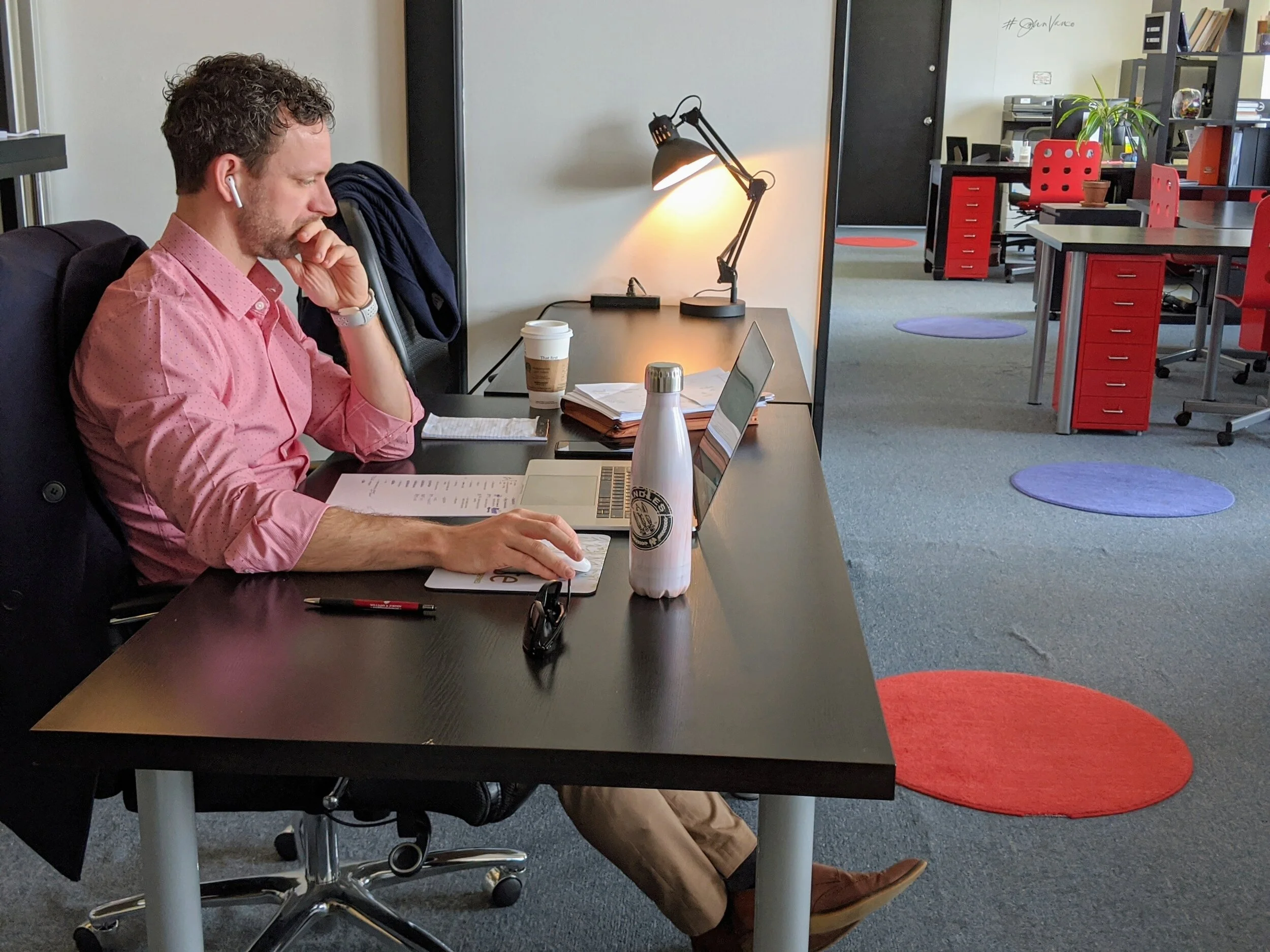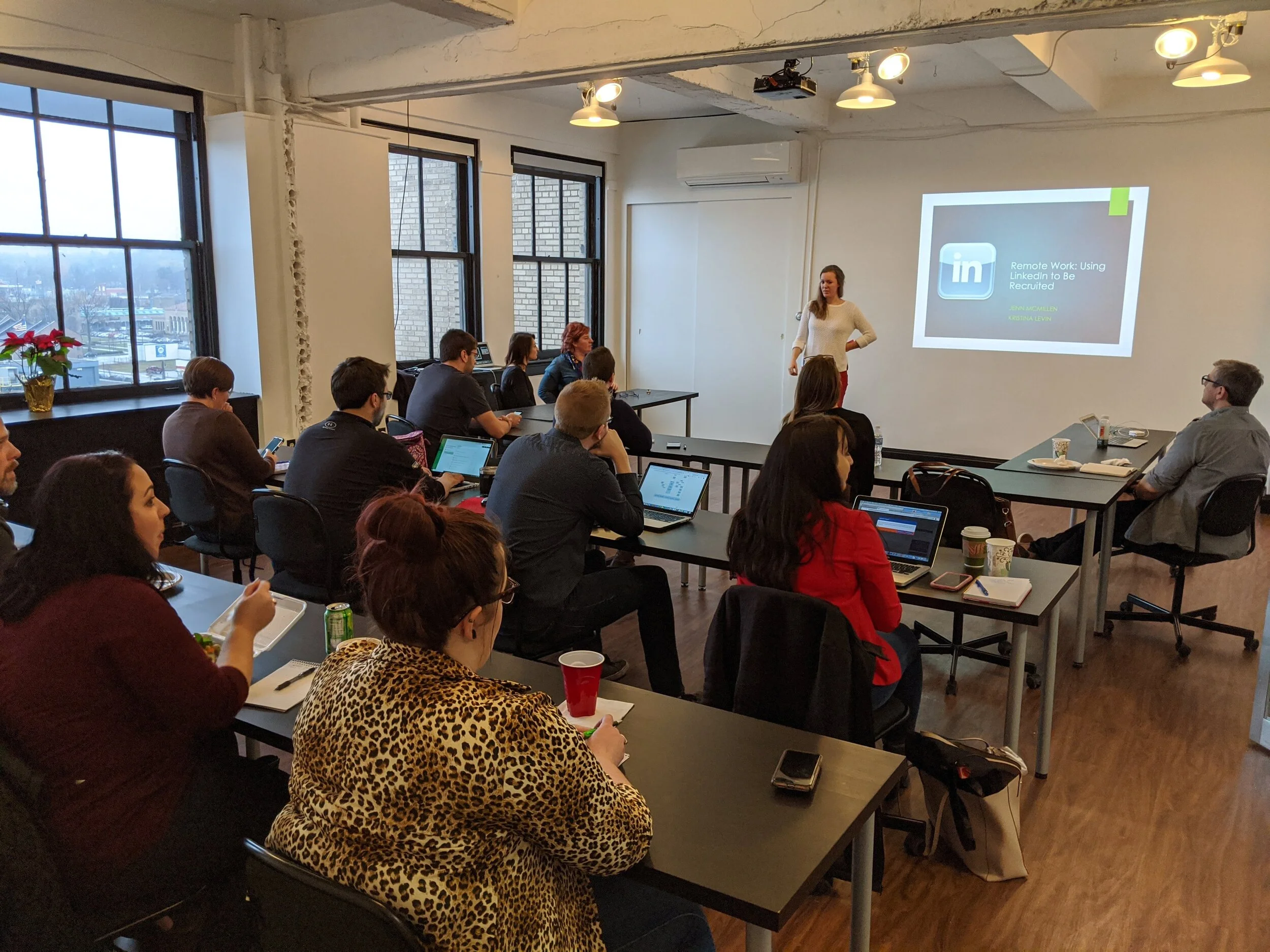Why Coworking Will Be Essential for the Economic Comeback of Small Cities
/By Sean Fedorko: I'm one of the founding members of Radius and lead the coworking community for several years. I've been active in grassroots community, civic, and economic development efforts since returning to Erie in 2015. I now support the new Community Leader of Radius as chair of the Advisory Committee.
As state governments lift temporary shutdowns on businesses and as schools return to in-person instruction, we’re starting to see a patchwork landscape of lost retail stores, restaurants, salons, and entertainment venues that have not survived the impacts of the COVID-19 pandemic. On top of that, while unemployment rates may be falling, millions of American’s are still underemployed, and many of those who were able to return to work did so for markedly less money (in June 2020, 10% wage cuts increased by 80% compared to pre-COVID levels).
As economists, researchers, and scholars continue to work to make sense of both the immediate and lasting economic impact, some clear patterns are emerging that lead me (and other coworking leaders) to believe that shared workspaces will become essential to economic recovery in the coming months and years, especially in small and mid-size cities.
For people forging new career paths in the wake of the COVID-19 crisis, coworking will help reduce startup costs, create new professional networks, become a source of well-needed optimism, and provide solutions to typically costly problems. They’re places where we will find peer mentorship in our work, but as importantly, they’re places where we will enrich our lives by sharing them with our neighbors, a sorely missed part of our days.
To highlight the specifics of why shared workspaces will be essential both amid and after the COVID-crisis, I worked with members of my own coworking space, Radius CoWork, on this article. In particular, I worked with Amanda Duncan, the new Community Leader at Radius and President of Young Erie Professionals to gather data from our members and to consult their diverse perspectives. We explore the current unemployment rates, the near-certain boom of new freelancers, remote workers, and small businesses, and the vulnerability of small-city economies.
*A brief note before we dive in: I know shared workspaces will need to be modified to meet social distancing guidelines and best practices, at least for a while. The coworking community is actively developing ways to adapt to post-COVID workspace needs. I’ll update this piece as new guidelines emerge. But it’s important to understand that new cleaning practices aren’t the biggest change we’re about to see.*
Unemployment Rates Have Skyrocketed; Now, Gig Work Will Too
According to the Bureau of Labor and Statistics, the national unemployment rate is 6.3%, down from 14.7% last spring. However, in a recent New York Times interview, Jerome Powell, the Federal Reserve chair, stated a different figure closer to 10%.
Why the discrepancy? This percentage includes the official unemployment rate plus those who:
Dropped out of the labor market since February 2020
Are misclassified because of a pandemic-tied “reporting quirk”
The Fed and the Treasury consider this figure the “real” unemployment rate.
While every city and state has been and will continue to be impacted by COVID-19 differently, regions with less-developed economic infrastructure will have the most difficult time bouncing back. Why would we think that? Because employment rates in non-metro counties still haven’t recovered from the Great Recession in 2008.
It's important to note, too, that the pre-pandemic economy was far from perfect, despite historically low unemployment. Hence the increasing necessity of the side-hustle. In 2018, Upwork and Freelance Union conducted a study that found that nearly 40% of gig workers started freelancing out of necessity, not by choice. Then in 2020 Upwork and Edelman Intelligence found that 36% of the total US workforce freelanced. That’s a lot of people trying to earn money independent of or in addition to secure employment
Of those relying on freelancing to supplement their incomes, 10% had to stop due to pandemic restrictions on their industries. Meanwhile, another 12% of the US workforce started freelancing in 2020. 54% of those new freelancers said they began out of necessity, and 75% said it was to achieve financial stability during the recession.
Of that same 12% who are new to freelancing, 96% of them said they are likely to continue freelancing in the future. The Upwork report also suggested that, compared to non-freelancers, freelancers are "overall better equipped to weather the COVID-19 storm."
It's also vital to understand that—even though overall freelancing workforce size has remained consistent—the proportion of those who report freelancing full-time is growing. Between 2019 and 2020, the percentage of full-time freelancers grew from 28-36%, with a majority of freelancers (59%) saying they're able to make more money as a freelancer than they'd make from a traditional employer.
If you look at one of the initial booms in freelancing between 2005 and 2015 (10.7-15.8% of the workforce), there is a clear correlation between high unemployment during the Great Recession (2008-2011), and the number of people who seek alternative sources of income. With current unemployment rates still unstable, we’re forecasting a massive increase in freelance workers.
While many freelancers have the ability to work from home (and with social distancing measures have had little choice), they often find it professionally isolating and emotionally lonely. Working from home comes with a litany of distractions, provides far fewer opportunities to learn from peers, and frankly, video-conferencing fatigue has taught us that Zoom isn’t an equivalent substitute for an in-person conversation.
Just as it has been for the past decade and a half, coworking spaces will continue to be the go-to workspace for people looking to connect with other professionals. They’re also a place to learn, be inspired, and work with people you want to work with. And they’re about to be filled with freelancers.
Remote Working Will Be Here To Stay
Even after businesses were allowed to reopen their doors, a significant portion of the workforce is still working from home. A recent Gallup poll found that 33% of U.S. workers are always working remotely and 25% are “sometimes” working remotely.
Twitter executives announced that they’re giving their employees the option to never come back to the office if they don’t want to. Spotify announced a permanent ‘work from anywhere’ policy to attract and enable a global workforce. Similarly, tech giants like Facebook, Google, Salesforce, and Slack don’t expect their workers to see the light of the office until late 2021.
Slack CEO Steward Butterfield told MarketWatch, “It’s hard to not see 20-40% of our workforce be remote… We need to make real-estate decisions long in advance, two to three years, and are in the speculative conversation now if we have 30%, 40% fewer desks.”
With a healthy bottom line always being top of mind, you better believe hundreds of businesses of every size will follow this trend. Without those headquarters, it can be challenging to provide the feeling of a professional culture. To feel a sense of community, remote workers often find themselves a tight-knit coworking group to join. It’s not that remote cultures can’t thrive, because they absolutely can, but when people want to be around others, and when they need a place where they can do that while working, they’ll almost certainly end up joining a coworking community.
Small Businesses are About to Boom
According to the data from the Brookings Institution, “heartland cities,” or those that are composed mostly of blue-collar workers, will probably be hit harder and more swiftly than their white-collar counterparts. Moreover, cities with “vulnerable economic compositions,” or those with 15% employment in high-risk industries, such as gambling, travel, and hospitality, and software, are in even more danger. Just how much danger has yet to be determined.
There’s a good chance that many businesses won’t be reopening their doors or rehiring their full staff back—at least in the near future. According to the Federal Emergency Management Agency (FEMA), 40% of businesses do not reopen after a disaster, and another 25% fail within one year of a disaster. However, unlike a natural disaster, COVID-19 is limited by neither time nor geography. Meaning, its reach, scale, and impact may be much more economically harmful than a hurricane or tornado.
With businesses folding and small cities already at an increased risk of economic recession, people will need to start again. While the pandemic cost the closure of many small businesses, the recovery will see the creation of many new businesses to fill those gaps. They’ll be restaurants, gyms, marketing agencies, food trucks, daycares, and a host of new and specialized products and software to meet the new needs of a very different world and workforce.
All of those entrepreneurs and small businesses will need to find affordable, innovative ways to make ends meet. They’ll have questions and challenges that will require peers and a broad business ecosystem to solve. Within coworking communities, the infrastructural cost to start a business is minimized and a network of professional talent and knowledge capital becomes immediately accessible. Coworking communities will be a differentiator that enables a higher percentage of these new businesses to succeed.
All this Coworking Growth will Positively Impact Local Economies
Coworking spaces are powerful word-of-mouth hubs. When something cool is happening locally, people talk about it. At Radius, members don’t just know about every new restaurant or business, they’re often involved in helping them get started. Coworking members typically have more flexible work hours, giving them the opportunity to explore what cities have to offer during the day, be it new lunch spots, public parks, mid-day art breaks, etc. And importantly, coworking communities are intersections of many otherwise unaffiliated networks, quickly transferring knowledge across industries and organizations.
I can tell you that the vast majority of coworking members are not eating lunch at chain restaurants. This little tidbit is a big part of why coworking matters. According to the Center for Community Economic Development at Michigan State University, for every $100 spent at a local business, $73 stays in the local economy, versus only $43 at non-locally owned businesses. Radius members have to make up some significant percentage of the income for Franco’s Cafe, our quick lunch spot, and I’m pretty sure the bartenders at Jekyll & Hyde and Cloud 9 know us by name. And we regularly frequent bars owned by our own members, Room 33 and Erie Ale Works. Coworking spaces bring people together from across a community and invest them in the wellbeing of a neighborhood (p.s. This is why picking the right site for your coworking space is incredibly important).
And we don’t just impact the economy as consumers. As connections are made, trust built, opportunities identified, and teams formed, many coworking members transition from working solo to becoming small-business owners and employers. As their businesses grow, they create new jobs that never existed before. By supporting each other and the broader community, we all grow together.
Coworking Our Way to Recovery
Times are difficult. There are more economic challenges ahead than ever before. What’s more, we have to overcome these challenges while being emotionally exhausted. Freelancers (especially those who resort to freelancing out of necessity), remote workers, and small businesses will have a challenging time post-pandemic.
But here’s what else I can tell you:
I’ve watched dozens of business owners who started with nothing but a laptop turn their businesses into pillars of the community. Seeing it happen so many times, I can tell you the five things that everyone seemed to need. You need a:
Computer
Internet connection
Good cup of coffee or tea
The willingness to solve the next problem, whatever it is
And a network of people who genuinely care about each other’s success and wellbeing
That last point is what truly separates coworking from both the couch and the cubicle. You can have your freedom and enjoy your networking, too. You can come and go without being tied to a physical space; yet, you can head to that space when you're looking to bump into others who are eager to help.
Coworking spaces support more than two million freelancers, remote workers, and small-business owners. And yes, those two million members contribute over $40 billion to the U.S. economy every year. But more than contributing to GDP, they’re communities of professionals who help each other, support each other, and believe in one another. They’re groups of people who are civically engaged and encourage others to support small businesses. They’re collections of people who, when you’re just about to give up, give others the support they need to keep going, even when the going gets tough. That’s why we’ve come to believe that coworking spaces are going to be an important differentiator between communities that recover quickly and those that struggle. If you’re one of the people trying to rebuild, don’t do it alone, reach out to a coworking community near you, let them know what you can contribute, and let them know what you need. We’ll be here for you.






